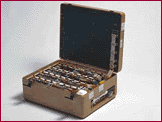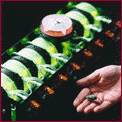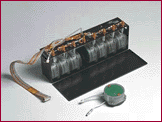




Objectives
Living organisms have what scientists refer to as a "circadian timing system" (CTS). The CTS behaves like an internal body clock that coordinates an organism's physiology and behavior, including sleep/wake, hormone and body temperature cycles with the external environment. Because they have a period of approximately 24-hours, these cycles are known as "circadian" rhythms. The clock controlling these rhythms is reset daily by external time cues. One of the most powerful time cues is the light/dark cycle.
This experiment was designed to study how the CTS of a simple organism such as the black-bodied beetle (Trigonoscelis gigas) responds to changes in the light/dark cycle while in microgravity. Scientists wanted to determine if the CTS showed evidence of adaptation during long-term exposure to microgravity. They also hoped to learn whether exposure to microgravity changed the sensitivity of the CTS to light.
Scientists know that disruptions in circadian timing adversely affect an organism's ability to respond to environmental challenges. On Earth, alteration of the CTS in humans has been implicated in such phenomena as jet-lag, problems associated with shift work, insomnia, and some forms of depression. Thus, the response of the CTS to prolonged space flight is of prime interest to scientists. Results from this study could add significantly to the understanding of gravity's influence on the circadian timing system.
Shuttle-Mir Missions Approach
Light-emitting diodes in the roof of each BAM provide lighting to the beetles. The scientists preprogrammed the lighting environment of the beetle kits, so each had a different lighting regimen. The protocol for beetle kit 1 allowed scientists to examine the response of beetle CTS to light exposure at different times of day. The lighting program in beetle kit 2 was designed to allow the scientists to investigate the response of the beetle CTS to a constant light environment.
In flight, the crew monitored the beetle kits weekly to ensure they were receiving power. A modified bicycle pump was used to ventilate the kits with fresh air. The beetles received no food or water in flight. Prior to loading the beetles into the BAMs, dry oatmeal was glued to the vertical surface of each BAM immediately in front of the beetle.
Following return to Earth, researchers downloaded the data onto a computer for analysis. The beetles remained in the kits for a period of time following landing so investigators could study re-adaptation to gravity.
Results
In beetle kit 2, the activity rhythms of insects kept in constant light had a significantly longer period than did those of insects kept in constant darkness. Researchers concluded that light intensity does have an effect on the biological clock in microgravity.
The research team will conduct the same experiment at Earth's gravity (1-G) and at twice Earth's gravity (2-Gs) on a centrifuge to compare with the results obtained in microgravity.
Earth Benefits Publications
Alpatov AM, Hoban-Higgins TM, Fuller CA, Lazarev AO, Rietveld WJ, Tschernyshev VB, Tumurova EG, Wassmer G, and Zotov VA. Effects of microgravity on circadian rhythms in insects. J. Grav. Physiol., in press, 1998.
Hoban-Higgins TM. Gravitational biology on Mir. J. Grav. Physiol., Invited paper. Presented at the NASA Outreach Workshop at the Nineteenth Annual International Gravitational Physiology Meeting. Co-sponsored by the International Society for Gravitational Physiology and the IUPS Commission on Gravitational Biology. Rome, Italy (1998).
Hoban-Higgins TM, Alpatov AM, Wassmer GT, and Fuller CA. Effects of gravity on insect circadian rhythmicity. Phase 1 research program interim results. Presented at 2nd Phase 1 Research Program Interim Results Symposium, Ames Research Center, Moffett Field, CA (March 31 - April 2, 1998).
Principal Investigators
Alexei Alpatov, Ph.D. Co-Investigators![]()
NASA-5
Two "beetle kits" were flown to the Russian Mir Space Station aboard Space Shuttle Atlantis. Once onboard Mir, the kits were connected to a power supply outlet and activated. Each beetle kit contained 32 "beetle activity monitors" (BAMs), each housing one beetle. Each BAM consists of a "revolving door"-type assembly that allowed the beetle to walk in a circular pattern while pushing the "door" ahead of it. The rotating assembly was in turn linked to an infrared sensor that recorded the motion electronically onto data logs for future review. In this way, researchers received a record of beetle movement that correlated to the beetles' rest/activity cycle.
All data were successfully downloaded and complete activity records were obtained from all 64 animals. Researchers were able to reset the biological clocks of the insects in beetle kit 1 by changing the light/dark cycle. Light that fell early in an animal's night reset the clock back to an earlier time while light that occurred late in an animal's night pushed the clock ahead to a later time.
An understanding of basic circadian physiology will lead to future research to improve the quality of life for all creatures. Learning how the circadian timing system influences physiological and behavioral functions will help researchers develop treatments for various disorders in humans such as jet-lag, problems associated with shift work, insomnia, and some forms of depression.
Hoban-Higgins TM, Alpatov AM, Wassmer GT, Reiveld WJ, Fuller CA. Response of insect activity rhythms to altered gravitational environments. J Grav Physiol 1997, 4(2):109-110.
Tana M. Hoban-Higgins, Ph.D.
University of California
Institute of Biomedical Problems
Charles A. Fuller
Gary T. Wassmer, Ph.D.
![]()
|
|
Curator:
Julie Oliveaux
Responsible NASA Official: John Uri |
Page last updated: 07/16/1999
.gif)